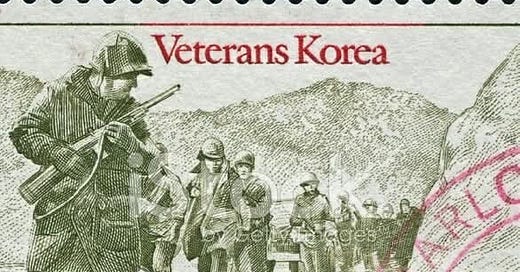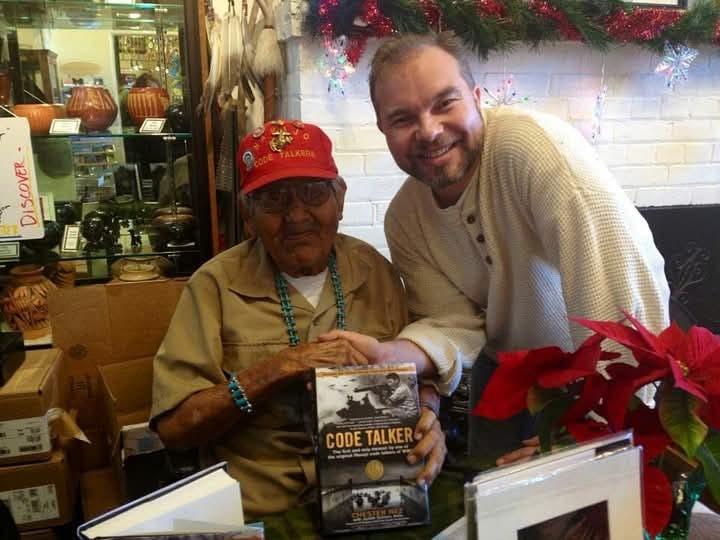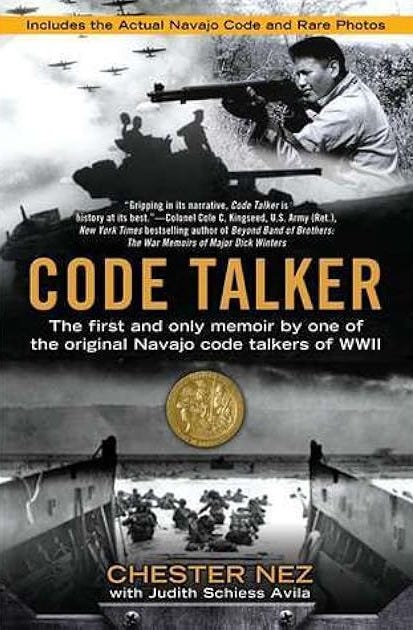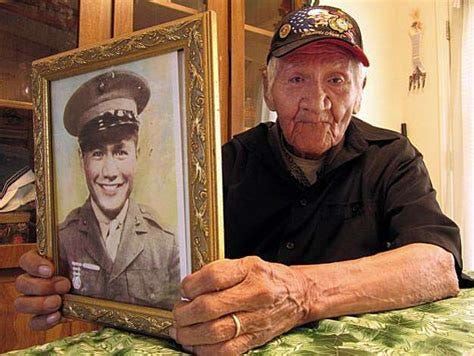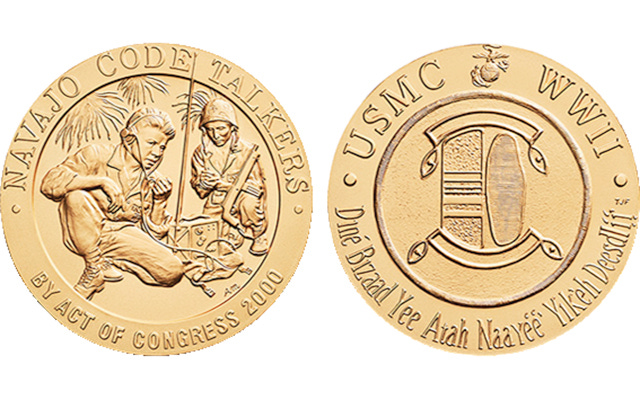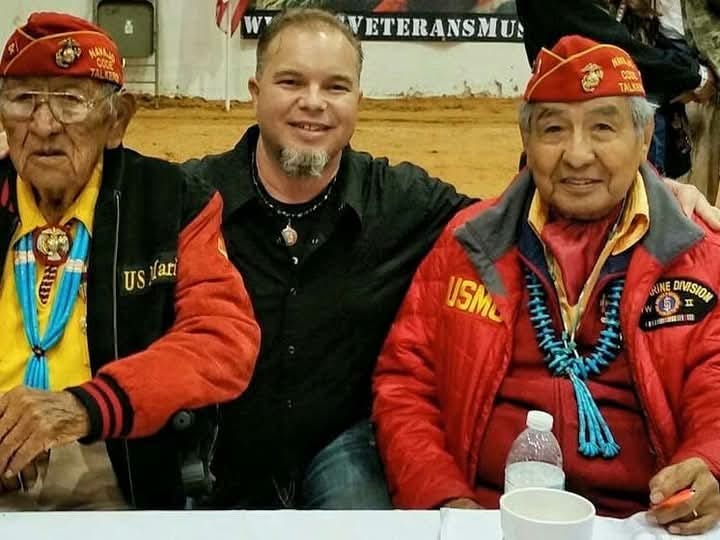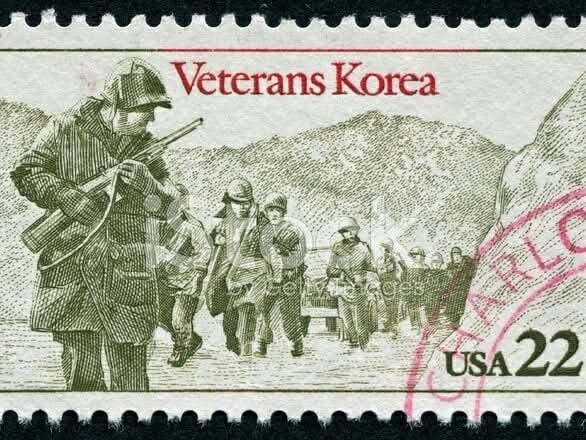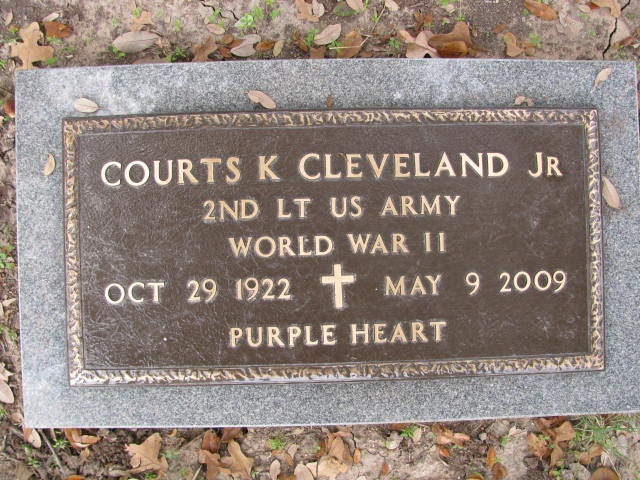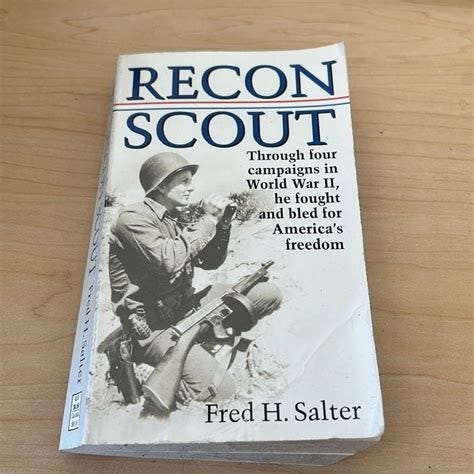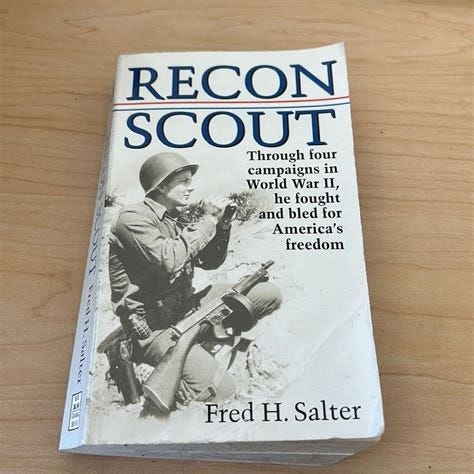Stories of Valor
Remembering Chester Nez, Carroll McGuinn, Courts Cleveland, Fred H. Salter & Dr. William Barnhart
Chester Nez
It was the close of 2012, a year memorable in its own right, but for me, it held special significance. It was the year I met Chester Nez—one of the last surviving Navajo Code Talkers of World War II. I was returning to the Navajo Nation for my job as a flight medic. I would fly into Albuquerque, New Mexico and then drive to Window Rock, AZ where I was based. It was there in old town Albuquerque, after stopping to have lunch, where I saw a banner hanging from a local store. “Meet Chester Nez- Navajo Code Talker.” At 91, his presence was humble yet profoundly impactful. Meeting him felt like holding history itself.
Chester Nez was born in Chi Chil Tah, New Mexico, and was still a young student in the 10th grade when he secretly enlisted to serve his nation. On May 5, 1942, Chester joined 28 other Navajo recruits forming the Recruit Training Platoon 382 at Marine Corps Base San Diego. This remarkable group would later create one of the most secure and effective military codes ever devised, the Navajo Code. The code’s effectiveness was first proven on August 7, 1942, during the fierce Battle of Guadalcanal, where Chester and his fellow Marines played a crucial role in turning the tide of the war in the Pacific. Chester also courageously served in battles at Bougainville, Guam, Angaur, and Peleliu, facing danger with extraordinary resolve.
Following his honorable service in WWII, Chester attended the University of Kansas, studying art. Financial constraints, unfortunately, led him to leave before graduation, but the university later recognized his dedication and achievements, awarding him an honorary bachelor’s degree in 2012. Chester returned to military service during the Korean War, ultimately earning the rank of Corporal. In civilian life, he served for 25 years as a painter at the Veterans Affairs Hospital in Albuquerque, New Mexico, retiring in 1974.
I vividly recall how Chester graciously autographed a copy of his memoir, "Code Talkers," for me—a keepsake of immeasurable value. Chester Nez passed away on June 4, 2014, leaving behind an enduring legacy. He was the last of the original 29 Navajo Code Talkers, heroes whose valor remained a classified secret until 1968. In 2001, their contributions were finally recognized with Congressional Medals—gold for the original 29 and silver for those who followed.
Chester Nez & Aaron Judkins
My journey continued in 2015 when I had the profound honor of meeting additional Navajo Code Talkers Peter MacDonald (right) and Dan Akee (left) in my hometown of Glen Rose, TX. I told them of meeting Chester and how I was honored to meet them as well. I thanked all of them for there service to our country. Each encounter reinforced the awe-inspiring nature of their contributions and sacrifices. These men, quiet and dignified, carried with them stories that could fill volumes, though often left unspoken, cloaked in humility.
Carroll McGuinn “Sarge”
The same admiration arose when I met another hero, Carroll David McGuinn, affectionately known to us simply as "Sarge." Sarge live in my hometown of Glen Rose, TX.
During the Korean War, Sarge once found himself on a perilous reconnaissance mission behind enemy lines. He was on a mission to get reconnacince troop movements from the North Koreans when suddenly he felt a rifle barrel point at the back of his head. He had been secluded in position but suddenly found himself at the mercy of a North Korean soldier. As Sarge slowly turned around, the North Korean motioned with his hand for a ciggarette. Sarge slowly pulled out his pack of ciggaretts and with his hand trembeling, gave the entire pack over. It was then that the North Korean sat down on the ground, smoked a ciggarrette, removed his bullets and lay down his rifle. The soldier surrendered, motivated by the desire for safety, regular hot meals, and humane treatment Sarge said grinning.
Carroll’s image graces the commemorative Korean War stamp, showing him courageously leading his men towards a landing zone. Sarge, who had a habit of sharing coffee and stories with us in the quiet hours of the early mornings, was a veteran not just of the Korean War but also the harrowing conflicts of Vietnam. He once confided about the tragic ambush shortly after the stamp photo was taken, an attack that claimed the lives of many of his men—a heavy burden he carried until his passing in 2009.
During his service in Vietnam, his tough leadership and uncompromising nature led to tensions with his men and superiors alike. Notably, he once punched a superior officer who insisted he attend a church service, resulting in the officer's reassignment rather than disciplinary action against Sarge. His barrack was later targeted by another soldier with a grenade but Sarge was not there.
Born in challenging times marked by racial tensions and violence, Sarge's formative years included witnessing several tragic events. As a younge boy, Sarge would walk several miles to the schoolhouse which took him across neighboring fields. One day he was walking to school, he noticed something swinging from a tree branch. As he got closer, he noticed a younge black boy had been lynched during the night and was hanged. This very much affected Sarge throughout his life. It was the unfortate reality of his time.
Yet another time, in his late teens, Sarge had a flat tire and was several miles out of town when he heard sirens in the distantace. He then noticed a car, speeding toward him at a high rate of speed. Sarge said the car approached, it suddenly stopped and pulled off the road near him. As the sirens grew louder, Sarge realized this man was being chased by the local police. He said the man jumped out of the car with a shotgun, looked at Sarge who was startled and said, "son, I'm not going to hurt you". He then ran down into the ditch and promptly shot himself in the head- all while young Sarge was looking on.
In the 1980s, Sarge's military expertise brought him to the Pentagon, where he carried the "nuclear football"—the briefcase containing nuclear launch codes—for President Ronald Reagan. It was Sarge who briefed President Reagan every day on matters of National Security. One March 30, 1981, Sarge was waiting for the President at the White House. The President's official itenarary was relatively light, and delivered a speech held in the ballroom of the Washington Hilton Hotel in Washington, D.C. It was shortly after that they all learned that the President had been shot, when a general approached Sarge and demanded the "nuclear football." Sarge had it handcuffed to his wrist. Sarge replied putting his hand on his sidearm, "you try to take this and you'll have three bullets in your chest." Sarge was no one to mess with.
After retiring from military service, Sarge joined the DC Capital Police. In one notable incident, overcome by anger at seeing protesters burning the American flag he had risked his life defending, he intended to confront them forcibly. Thankfully, he was stopped by the Secret Service. Following this incident, he immediately resigned, eventually settling into civilian life in Glen Rose, Texas. Carroll McGuinn passed away on September 10, 2009, at the age of 79.
Courts Cleveland “Bub”
Among these cherished memories is also my encounter with Mr. Courts Cleveland, a veteran whose service in World War II placed him directly under the command of the legendary General George S. Patton.
Courts Kendall "Bub" Cleveland Jr., was born on October 29, 1922, in Acton, Texas, Courts was the fourth child and only son of pioneering parents Courts Kendall Cleveland Sr. and Olga Collins Cleveland.
Courts was part of the first graduating class at Arlington Heights High School in 1940, where he notably played football against the famed Masonic Mighty Mites. He continued his education at Texas A&M University, volunteering alongside his entire class for military service when World War II erupted.
During the war, Courts served valiantly as a lieutenant in the 93rd Cavalry Reconnaissance Squadron, 13th Armored Division under the command of General George S. Patton. Cleveland was one of Patton’s reconnaissance scouts—soldiers whose roles required remarkable bravery and unwavering fortitude. When wounded in battle, it was General Patton himself who helped carry Cleveland from the frontline to safety. This incident was instrumental in Patton earning his nickname, "Blood and Guts," symbolizing his fierce determination and hands-on leadership in combat helping to escort Courts coming off the front line. Courts sustained multiple injuries during combat and was awarded six Purple Hearts before his honorable discharge on December 29, 1945, as an armed reconnaissance unit commander. His wartime exploits were significant: participating in the Allied invasion of 1944, aiding in the liberation of several prisoner-of-war camps, and personally accepting the surrender of Düsseldorf, Germany.
Returning home from the war, Courts became a prominent figure in Texas agriculture, successfully managing numerous cattle ranches for over five decades and significantly contributing to the establishment of Longhorn cattle as a recognized breed in Texas. He was deeply committed to community and charitable activities.
Mr. Cleveland requested that I tell his extraordinary story be documented and shared widely—a task I considered an immense honor. Sadly, he passed away before we could see this goal realized on May 9, 2009.
His family heritage included his great-grandfather, William Green Randle, who moved from Tennessee to Texas in 1871, and whose family generously donated the land for the Acton Cemetery, where Courts was laid to rest.
Reflecting on these incredible individuals—Chester Nez, Carroll McGuinn, Courts Cleveland—I am constantly reminded of the sacrifices that ensure our freedom today. Their stories are compelling reminders of the cost of liberty and bravery's lasting imprint on history.
Let us never forget: freedom is not free!
#MemorialDay #NeverForget
Fred Salter
Another remarkable veteran is Fred Salter, author of the compelling memoir "Recon Scout."
Fred H. Salter led a life marked by adventure and resilience. Born on August 19, 1922, in Gulph Mills, Pennsylvania, he grew up in the hills of Pennsylvania, running a trap line and playing fiddle in a hillbilly band at barn dances. As a teenager, he joined the U.S. Horse Cavalry and served as a reconnaissance scout during World War II.
Salter was not only a soldier and farmer but also a musician, writer, and poet. He played country music throughout the valley and authored two books: Recon Scout, detailing his wartime experiences, and The Maverick Tumbleweed. His vivid storytelling in Recon Scout offers a firsthand account of the perils and camaraderie experienced by reconnaissance scouts during the war.
Born in Pennsylvania, Salter's early life was steeped in the rugged outdoors—running trap lines and playing fiddle at barn dances. At just 17, he forged his father's signature to enlist in the U.S. Horse Cavalry, embarking on a military journey that would take him from the sands of North Africa (1942–1943), to the mountains of Italy (Sicily 1943-44).
Assigned to the 91st Cavalry Reconnaissance Squadron, Salter's role evolved from traditional cavalry to mechanized reconnaissance as the unit transitioned from horses to jeeps. He specialized in perilous night patrols, often venturing alone into enemy territory to gather critical intelligence. His service under General Patton included key campaigns in Tunisia, Sicily, and the grueling battles up the Italian peninsula, notably the grueling battle of Monte Cassino.
Salter's memoir doesn't shy away from the brutal realities of war. He candidly shares the psychological toll of combat, expressing regrets and the haunting memories that lingered long after the war's end. His narrative is interspersed with poetry and reflections, offering a deeply personal account of a soldier's life on the front lines.
After the war, Salter's adventures led him across the United States and Canada as a hobo riding the trail rails leading which is chronicled in his second book, “The Maverick Tumblweed”. He eventually found peace and settled in Alaska with his wife, Pauline, raising three sons in a log cabin on the shores of Auke Bay. Following Pauline's passing, he remarried and continued his love for the outdoors, farming in Montana's Swan Range and returning to Alaska each summer. He wrote of these accounts in “Forever on the Edge”- FROM THE APPALACHIAN MOUNTAINS, TO THE WILDS OF ALASKA AND THE ROCKY MOUNTAINS Of THE WEST.
I was the first to write a review of Recon Scout for Mr. Salter in 2001 for Barnes & Noble. Although I never had the honor to meet Mr. Salter personally, I did know his brother-in-law Mr. Gibbs quite well as he lived in my town of Glen Rose, TX. It was Mr. Gibbs who gave me a copy of the book. Later, Mr. Salter corresponded with me by snail mail and he responded that he very much appreciated the review. I thought I would repost my original book review here for Amazon.
My Book Review:
"Recon Scout" by Fred Salter rivals the movie 'Saving Private Ryan' with the exception that this author did not play an actor in the movies; he lived through every account written about. A true story, this masterpiece takes you back in time through one persons' life in WWII. You will take a personal tour with a recon scout who entered the war as a country boy and came out a survivor. You will journey to foreign lands on the front lines of battle where sand and water are stained with American blood fighting against tyranny and one young man in the midst of hell on earth. "Recon Scout" makes the reader vividly aware what it is like to endur war and to appreciate human life. The book quote,"I lived a thousand deaths" is sadly accurate. Its historical content is very valuable, its lessons are hard learned, and its humor is witty. This book makes Time Stand Still. "Recon Scout" is very easy to read and flows fluently throughout its chapters. The reader will find themselves right along side this recon scout as the story unfolds. A MUST read for this generation of young people studying history or as a general interest in WWII. A word of caution however. Its desciptions of war can be graphic. To summerize "Recon Scout"-Freedom is not Free!
Recon Scout is more than a war memoir; it's a vivid journey through history, seen through the eyes of a man who lived it. For anyone seeking to understand the personal sacrifices behind the broader strokes of World War II, Salter's account is an indispensable read. His story stands as a testament to the courage and resilience of those who served, reminding us that the freedoms we enjoy were hard-won by individuals like Fred Salter.
Fred H. Salter passed away on September 3, 2004, at his home on Foothill Road in Kalispell, Montana, at the age of 82. He was buried at C.E. Conrad Memorial Cemetery.
Dr. William Barnhart
Dr. William Barnhart was more than a respected podiatrist in Granbury, Texas—he was also a veteran of World War II who served honorably as a combat medic. During our conversations, he once shared a vivid memory of his unit capturing a massive Nazi flag after entering Berlin. It was a powerful moment in his life that marked the triumph of Allied forces and left a lasting impression on him.
After the war, Dr. Barnhart devoted his life to medicine, choosing the field of podiatry. He served the Granbury community with compassion and diligence for many years, building a reputation not only for medical excellence but for genuine care for his patients.
I came to know Dr. Barnhart under different circumstances—he was one of my patients in the ICU. His recovery was slow, and one day, I could see the weight of discouragement settling in on him. As we spoke, I learned something that changed everything: Dr. Barnhart had a deep love for archaeology, particularly biblical archaeology.
The next day, I brought two small artifacts from my own travels in Israel—a coin and an ancient oil lamp. When I placed them in his hand, he looked down and quietly said he couldn’t make out the details. He tried to return them, but I gently placed them back in his hand and told him they were a gift—something he could study more closely once he made it home. For a moment, his spirit lifted. You could see it in his eyes. He was deeply touched.
I had always hoped to write Dr. Barnhart’s story, to preserve the legacy of his service, his love of history, and his quiet resilience. But that opportunity passed when he died on May 8, 2008. Though his life’s story may not have filled in the pages of a book, it certainly left an imprint on those who knew him.
As we commemorate this Memorial Day, let us remember these courageous individuals and countless others who have valiantly served our nation. Their bravery and sacrifice stand as powerful reminders that FREEDOM IS NOT FREE.
Here’s to their life of service and quiet strength. Godspeed my friends..
In memory of: Chester Nez, Carroll McGuinn, Courts Cleveland, Fred H. Salter and Dr. William Barnhart


